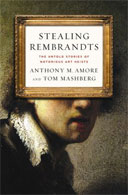Stealing Rembrandts: The Untold Stories of Notorious Art Heists

Authors: Anthony M. Amore and Tom Mashberg
Publisher: New York: Palgrave Macmillan, 2011. 241p.
Reviewer: Stacy Hauck | March 2012
For millennia, the fine art and antiquities market has been plagued with theft). Compared to other illicit trade (i.e., drugs and weapons) the theft of high-value art is generally ignored; yet valued at over $6 billion a year, the trade in stolen art should be taken seriously according to Anthony Amore and Tom Mashberg (p. 13). In Stealing Rembrandts, Amore and Mashberg collaborate to uncover how art criminals operate. Drawing from his previous experience as the security director of the Isabella Stewart Gardner Museum (ISGM), Amore infuses this catalogue of Rembrandt heists with experience gained in pursuit of thirteen works of art, including three Rembrandts stolen from the ISGM March 18th, 1990. Tom Mashberg in turn adds insight developed from his work as an investigative journalist for the Boston Herald (1994-2010). These authors skillfully weave explicit descriptions of specific cases with Rembrandts’ life stories. The combined effect is a contextualization of art theft and the specific stolen objects.
Through the detailed treatment of a small number of cases, involving one of the most stolen artists (second only to Picasso), the authors intend to accomplish two aims. First and most importantly, is to draw the attention of the general public and specialists alike to the conditions that facilitate theft in order to promote the adoption of more effective crime prevention strategies, as well as promoting the successful investigation and recovery of stolen art. Second, the authors inform the reader about Rembrandt — who he was, and why his works have been a continuous target for thieves.
Amore and Mashberg draw upon a variety of sources to describe how major works by Rembrandt were stolen. Interviews with law enforcement personnel and convicted art thieves are supplemented with media sources (i.e., newspaper stories and interviews with journalists) as well as court documents. Pertinent case information was extracted and compiled into case narratives. Important actors in each case were identified and a database was constructed of names, addresses, and other personal information such as birth and death dates. Each case was then analyzed in a chronological fashion starting with planning activities, a description of incident details, and the aftermath. In some instances the aftermath was significant, where the perpetrators were identified, convicted, and sentenced.
Chapter composition is mixed. Detailed case narratives are interspersed with general discussions about theft, and stories about Rembrandt’s life. Of particular interest to criminologists are the step-by-step accounts revealing how the thieves infiltrated the museums or residences, orchestrated heists, and used the objects. Interviews of the thieves reveal varying motives– ransom, the thrill of possession, and financial gain. This analysis also serves to highlight the situational factors that provided the opportunity for theft, and the prevention efforts that were employed post-theft to prevent future victimization. For example, an objects’ provenance should not be stored with the painting; individuals hired to catalogue art collections should be supervised, and accounting mechanisms initiated; and staff should be properly vetted.
The general public gains a greater awareness of the inner workings of the art industry with stories of how Rembrandt grew to such fame and how crucial his role was within the art world — given he was both a creator of art and an art dealer. Tracing the rise and fall of Rembrandt’s popularity, these sections connect elements of his artistic style with the paintings created. For the readers who are not familiar with the art market, these narratives help to understand the valuation of certain pieces and how the value of one piece could be significantly higher than that of another, even though the creator is one and the same.
One critical failing of the book is the absence of a concluding argument; a summary of the situational factors and relevant crime prevention strategies would have been useful. As is, it seems as though the book is unfinished. If the stated goal was to draw our attention to the conditions that make art vulnerable to theft, then it would seem to follow that the authors offer the reader a concise and thorough analysis of the policy implications that accrue from the cases presented. To the criminologist, understanding why Rembrandt pieces are targeted and what owners can do to prevent theft is more instrumental to the protection of art than a detailed report of how Rembrandt was commissioned for his first piece, and the ups and downs of his various social relationships.
Stacy Hauck is a Research Associate at the Center for Criminal Justice Research, California State University, San Bernardino.


